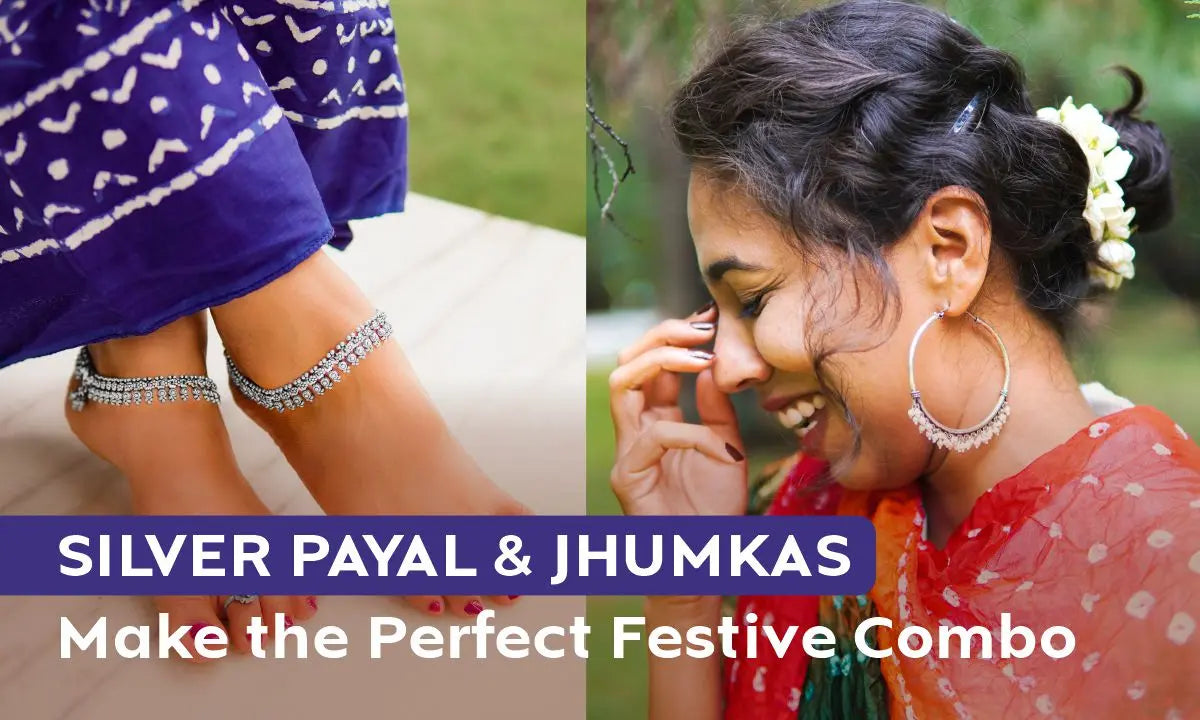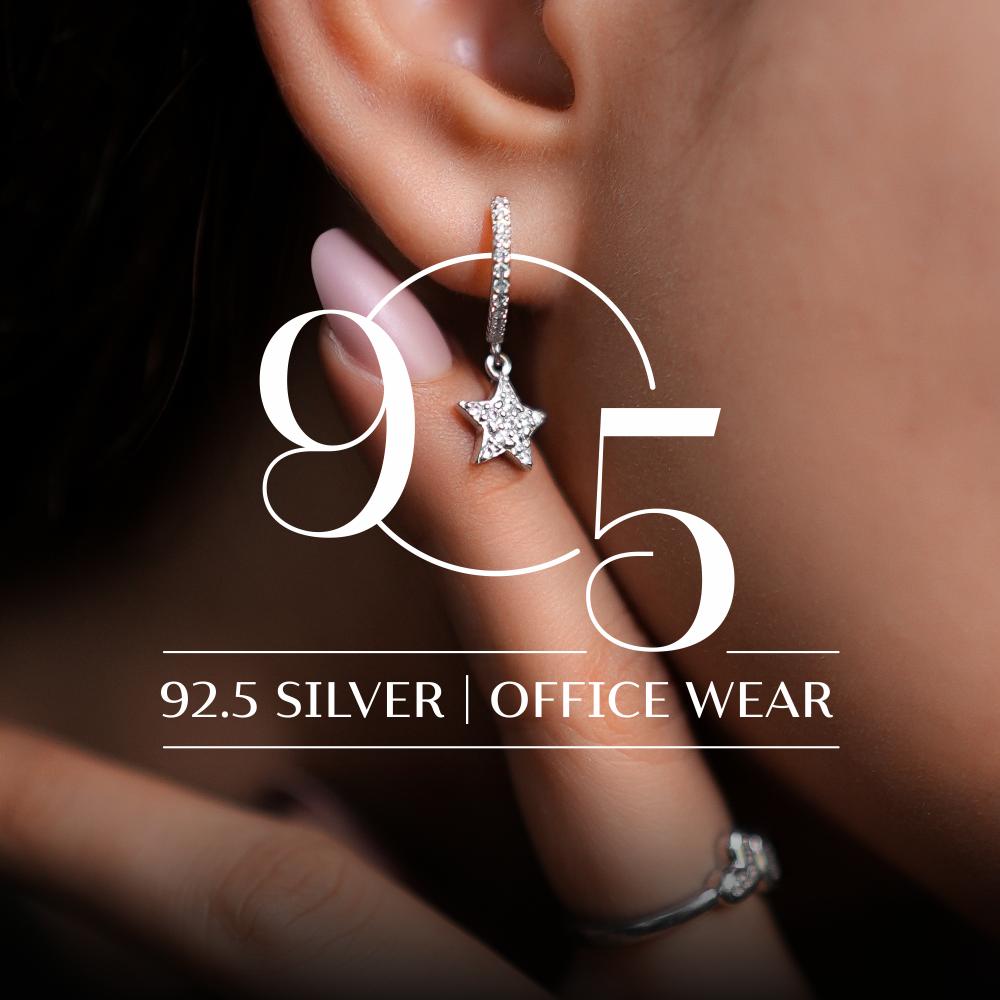
Why Silver Payal and Jhumkas Make the Perfect Festive Combo
Festivals in India are not just about rituals; they are about radiance. They are moments when families come together, homes gleam with lights, and people dress in their finest attire. Jewellery plays a central role in these celebrations—adding sparkle, symbolism, and grace to the occasion.
Among the countless adornments, two stand out as timeless festive favourites: the silver payal (anklet) and the jhumka (earring). Each carries centuries of tradition, cultural depth, and beauty, but together they create a combination that feels both rooted in heritage and strikingly contemporary.
The Ancient Roots of Payals and Jhumkas
Payals in Indian Culture
Payals, or anklets, are among the oldest known ornaments in India. Archaeological finds from the Indus Valley civilization (c. 2500 BCE) include anklets, proving their presence in ancient society. In mythology, goddesses and celestial dancers are often depicted wearing silver anklets, their delicate sound symbolising both rhythm and auspiciousness.
Traditionally, silver has been the chosen metal for payals. Unlike gold, which is reserved for the upper body in Hindu custom, silver is associated with the earth and the feet, signifying grounding, humility, and purity. Payals were also considered protective charms, warding off negative energy as one walked.
Jhumkas Through the Ages
The jhumka has been equally enduring. Its bell-like form appears in temple sculptures, paintings, and poetry. During the Gupta and Mughal periods, jhumkas were crafted in silver and gold, adorned with pearls or gemstones, and worn by queens, courtesans, and dancers.
The jingling of jhumkas came to symbolise feminine beauty. In classical Sanskrit literature, poets often described the sway of jhumkas as an emblem of elegance and charm. Even today, folk songs across India celebrate the allure of the “jhumka ki jhankar” (the tinkling of jhumkas).
Rituals and Symbolism
Festivals in India are incomplete without jewellery, and payals and jhumkas hold special significance in rituals:
-
Weddings: Brides traditionally wear payals as part of their solah shringar (sixteen adornments). They symbolise grace, fertility, and prosperity. Jhumkas, meanwhile, frame the bride’s face, drawing attention to her beauty.
-
Dance and Devotion: Classical dancers wear heavy anklets and ornate jhumkas, their movements accompanied by rhythm and sound. In temple rituals, silver payals and jhumkas are even offered to deities as a mark of devotion.
-
Festivals: From Diwali to Navratri, women across India choose payals and jhumkas to complete their festive ensembles. The shimmer of silver, combined with the delicate sounds, transforms every step and gesture into part of the celebration.
Ancient Beauty Standards
Indian beauty ideals have always emphasised adornment from head to toe. In ancient texts like the Natya Shastra, jewellery was considered an extension of rasa (aesthetic experience). The jingling of anklets or the sparkle of earrings was not just ornamental but part of how beauty was performed and perceived.
Silver payals and jhumkas became iconic because they engaged multiple senses:
-
Sight (shimmer of silver, intricate design),
-
Sound (gentle bells or ghungroos),
-
Symbolism (auspiciousness, grounding, protection).
Even today, when modern fashion leans towards minimalism, these pieces retain their aura because they embody more than surface beauty—they embody rhythm, tradition, and meaning.
Why the Combo Works: Payal + Jhumka
The charm of pairing silver payals with jhumkas lies in their harmony. Both are rooted in sound and movement—the tinkle of anklets echoes the sway of earrings. Together, they complete a festive look in a way few other jewellery combinations can.
-
Balance: Payals adorn the feet, while jhumkas frame the face—creating symmetry from head to toe.
-
Tradition: Both pieces are culturally rich, often seen in classical art and rituals.
-
Versatility: Whether with a saree, lehenga, or kurti, the payal-jhumka combo elevates the outfit instantly.
-
Luxury in Silver: Crafted in sterling silver, they carry both auspiciousness and affordability, making them accessible yet prestigious.
Styling Silver Payals for Festivals
Silver payals come in many designs—delicate, heavy, engraved, or studded with ghungroos. For festivals, lighter designs work best for long hours of wear. A piece like the Sūkṣma (सूक्ष्म) Payal, with its fine and intricate design, embodies the art of subtle grace while still making an impact (View Product). It’s ideal for women who want to look elegant without heavy ornamentation.
Pairing such designs with traditional attire ensures comfort while retaining charm—perfect for festive dances or long hours of celebration.
Styling Silver Jhumkas for Festivals
Silver jhumkas are festive staples. They range from oxidised designs for casual elegance to grand, gemstone-studded creations for weddings and special occasions.
A standout choice is the Kavya-Kundna Silver Jhumka from Silvogue’s Nakhre Collection. Bold, colourful, and eye-catching, it is designed to wow, making it perfect for festive evenings when you want every movement to sparkle.
When styled with sarees, lehengas, or even Indo-Western festive wear, these jhumkas frame the face beautifully, ensuring that your festive photographs capture elegance with every smile.
Modern Interpretations
The modern woman doesn’t always want heavy, ornate jewellery. Many prefer minimalist yet meaningful pieces. This is where silver excels—it balances cultural depth with contemporary style.
A delicate payal paired with bold jhumkas creates a striking contrast—subtle at the feet, dramatic at the face. For those who prefer balance, pairing medium-sized payals and moderately ornate jhumkas provides harmony without excess.
Festivals like Diwali or Navratri today are as much about house parties and office celebrations as they are about rituals. The payal-jhumka combo adapts seamlessly, bringing heritage into modern contexts.
Caring for Your Festive Silver
To ensure your silver payals and jhumkas retain their shine:
-
Store them in anti-tarnish pouches.
-
Wipe after use to remove sweat or moisture.
-
Avoid spraying perfumes or hairsprays directly on them.
-
Clean occasionally with mild soap and water or a polishing cloth.
These simple rituals mirror the care our ancestors gave to silver ornaments, ensuring they lasted generations.
Why Choose Silvogue by Ranka Jewellers?
Festive jewellery demands authenticity and craftsmanship. Silvogue brings the assurance of hallmarked 925 silver, blending heritage designs with modern aesthetics. From delicate payals like the Sūkṣma to bold statement jhumkas like Kavya-Kundna, the collections reflect artistry, authenticity, and cultural continuity.
Conclusion
Festivals are about beauty, rhythm, and meaning—and few jewellery combinations capture these qualities as perfectly as silver payals and jhumkas. Rooted in history, tied to rituals, and celebrated in art and poetry, they remain as relevant today as they were in ancient courts and temples.
The payal grounds your steps in tradition, while the jhumka frames your face with elegance. Together, they create a festive symphony—one of movement, sound, and shine.
With modern collections from Silvogue offering everything from subtle grace to bold brilliance, this timeless combination continues to enchant. So this festive season, let your every step jingle and every glance sparkle—with silver payals and jhumkas, the eternal duo of Indian adornment.




